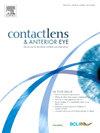Epidemiology of ocular surface symptoms and their association with stress levels among the Gazan population in crowded shelters during the 2023 Israel war
IF 3.7
3区 医学
Q1 OPHTHALMOLOGY
引用次数: 0
Abstract
Purpose
To investigate the status of ocular surface symptoms and their relationship to stress levels among the Gazan population during the 2023 Israel-Hamas War.
Methods
This cross-sectional study involved stratified sampling of participants from the four Gaza districts in Palestine. Individuals aged 18 years or older completed the Arab Ocular Surface Disease Index (Arab-OSDI) questionnaire and the Perceived Stress Scale (PSS-10) to assess stress levels.
Results
A total of 426 participants (238 males and 188 females) completed the Arabic versions of the OSDI and PSS-10 questionnaires. The mean Arab-OSDI score was 21, with 40.6 % of participants scoring ≥23, the threshold for moderate to severe DED symptoms. Participants with moderate or high perceived stress levels had significantly higher mean Arab-OSDI scores than individuals with low stress levels (p = 0.029). Logistic regression analysis identified age over 50 years, and the high PSS as significant factors associated with Arab-OSDI scores ≥13 (p < 0.05).
Conclusion
The findings indicate a high prevalence of dry eye symptoms among the Gazan population during the Israel–Hamas war in 2023, with moderate to high perceived stress levels significantly associated with these symptoms.
2023年以色列战争期间拥挤的避难所中加沙人口眼表症状的流行病学及其与压力水平的关系
目的:调查2023年以色列-哈马斯战争期间加沙居民眼表症状的状况及其与应激水平的关系。方法:这项横断面研究涉及来自巴勒斯坦加沙四个地区的参与者分层抽样。年龄在18岁或以上的个体完成了阿拉伯眼表疾病指数(Arab- osdi)问卷和感知压力量表(PSS-10)来评估压力水平。结果:共有426名被试(男238名,女188名)完成了阿拉伯文版本的OSDI和PSS-10问卷。平均阿拉伯- osdi评分为21分,其中40.6%的参与者得分≥23分,这是中度至重度DED症状的阈值。中等或高度感知压力水平的参与者的平均阿拉伯osdi得分显著高于低压力水平的个体(p = 0.029)。Logistic回归分析确定年龄超过50岁和高PSS是与阿拉伯- osdi评分≥13相关的重要因素(p)结论:研究结果表明,在2023年以色列-哈马斯战争期间,加沙人口中干眼症状的患病率很高,中等至高的感知压力水平与这些症状显著相关。
本文章由计算机程序翻译,如有差异,请以英文原文为准。
求助全文
约1分钟内获得全文
求助全文
来源期刊

Contact Lens & Anterior Eye
OPHTHALMOLOGY-
CiteScore
7.60
自引率
18.80%
发文量
198
审稿时长
55 days
期刊介绍:
Contact Lens & Anterior Eye is a research-based journal covering all aspects of contact lens theory and practice, including original articles on invention and innovations, as well as the regular features of: Case Reports; Literary Reviews; Editorials; Instrumentation and Techniques and Dates of Professional Meetings.
 求助内容:
求助内容: 应助结果提醒方式:
应助结果提醒方式:


